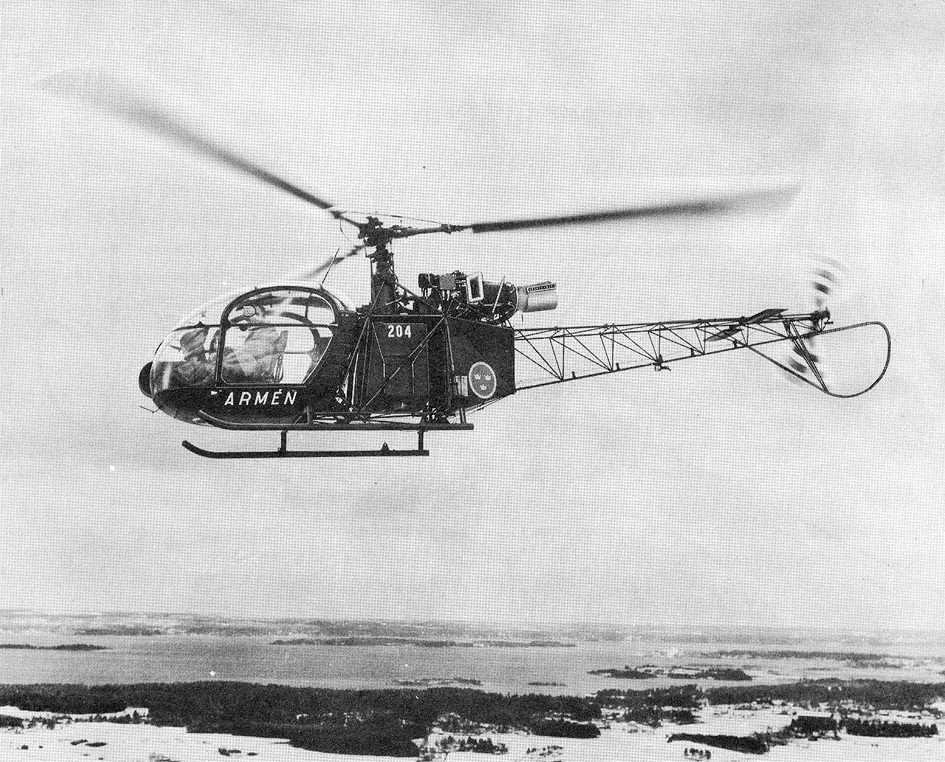Lightweight helicopter wanted
As the Swedish Navy began work on establishing its own helicopter units, it was decided that there would be a need for two types of machine, one heavy and one light. The heavy machine turned out to be the formidable H-21 (also known as the Vertol 44) ”Flying Banana”, which was assigned the Swedish designation HKP 1.
Initially the light helicopter requirement seemed to be met by the Bell 47, famous from the Korean War (as seen in the TV series ”M.A.S.H.”) but its performance was deemed inadequate. Instead interest switched to the new French Alouette II and this gained acceptance. In 1959 the first eight were delivered from the SAAB facility in Norrköping where they had been assembled.
In the end the Air Force (which had earlier declared itself not to be interested in helicopters) also become interested and acquired four Alouette II. These were at first called Tp 84 but quite soon ideas changed and they were given the type assignation HKP 2.
There is a place on Earth where the Sun never shines…
At the same time that the Swedish Navy began to study helicopters, the Army had also been following developments with interest and started their own investigation. Above all, it was in the endless wastes of Northern Sweden where it was realised that the unique qualities of helicopters could be extremely useful. In parallel with the Army applying to set up its own Artillery Aviation organisation in 1956, the possibilities offered by helicopters began to be studied. In the autumn of 1956, in co-operation with the Ostermans Aero company, practical trials began with a Sikorsky S-55, and later during 1957 also with three Bell 47 machines.
The Army was able to find that helicopters were indeed very useful. In areas with no roads they provided the facility to maintain contact between dispersed units, even when radio contact failed. Transport of key staff, evacuation of the injured, relocation of reconnaissance patrols and the movement of equipment were all made much easier. The helicopters could also complement the Army light aircraft such as the Piper Cub and Super Cub in forward observation for artillery.
Such a place is called Boden…
It was therefore with leased civilian helicopters that the Swedish Army began to set up what would become the Helicopter School and the Army Aviation battalion AF 1 at Boden. In the event of hostilities, civilian helicopters would be put into military service. The Helicopter School’s first two helicopters of its own, two HKP 2 aircraft, arrived at Boden on 9 December 1959, the first of many more.
A major advantage of having the Helicopter School based at Boden was the severe climate that demanded much from the aircrews and ground personnel. Once one has learnt to fly, perform maintenance and fight in the demanding Northern winters, doing so in the rest of Sweden would be no problem. The HKP 2 was shown to operate well in Norrbotten, the northernmost county of Sweden, during harsh winters, even though it was found that this model was not entirely battle-worthy. Unlike those in the Navy, the Army’s helicopters needed to be able to hide among trees and be camouflaged just like any other Army unit. Out in the field they were all housed in tents, the same as the Army’s soldiers, in which maintenance would also be carried out. The three-bladed main rotor was more difficult to manage among trees than the two-bladed main rotor of the Bell 47.
Despite the camouflaging and other problems the Army airmen soon discovered that in the HKP 2 they had a real workhorse that could do almost anything asked of it. The first real rescue mission showed this to be very clearly true. The alarm sounded on New Year’s Eve in 1959. Three Sami (Lappland reindeer herders) had been reported missing in the Kvikkjokk area and the Helicopter School commanding officer Gunnar Zachrisson accompanied by his number two Gustaf Ekholm set off. On the way, they picked up the Jokkmokk police chief.
This trio managed to find the three lost Sami and their three dogs in good condition. Gunnar Zachrisson noted that this was the first time he would learn that a Sami reindeer herder really consisted of both a man and his dog. Apparently the police chief had naturally assumed this and not bothered to explain it beforehand. So the Alouette now really had to show its mettle. Undaunted, the helicopter lifted off with all six grown men and the three dogs, which Gunnar Zachrisson described as ”quite a hefty load”. Despite everything this first mountain rescue mission ended successfully and the Army fliers learned that the Alouette was capable of handling more than could be expected at first sight.

Photo: Swedish Air Force museum in Linköping
